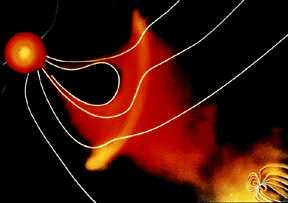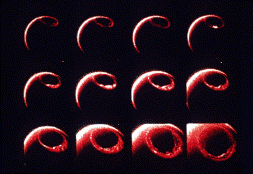This picture shows material from the Sun coming towards the Earth. It is the Sun's magnetic field carried in this material that causes magnetic storms.
NASA
Geomagnetic Storms
From May 1806 until June 1807, from his home in Berlin, Baron Alexander von Humboldt observed which way the magnetic needle was pointing. On December 21, 1806, he recorded strong magnetic disturbances. The same night he saw auroral lights. In the morning, the aurora was gone, the magnetic disturbances were gone. Humboldt was left though with his discovery of the geomagnetic storm.
A geomagnetic storm is just what Humboldt recorded, a disturbance of the Earth's magnetic field.
The solar wind carries with it the magnetic field of the Sun. This magnetic field or the IMF (interplanetary magnetic field) has a particular orientation - southward or northward. If the IMF of the solar wind is southward and the solar wind crosses the Earth for long periods of time, geomagnetic storms can be expected. The southward IMF causes magnetic and particle energy to be injected into the Earth's magnetosphere creating storms.
Just in the last 30 years have scientists truly begun to understand the coupled Sun-Earth system. Many of the improved theories are due to satellites such as Yohkoh and Ulysses. It is extremely important to understand such storms because of the effects they have on life on Earth. Geomagnetic storms can affect radio communication, satellite drag, auroral activity and even the safety of astronauts in Earth orbit.
You might also be interested in:

For a planet to be affected by a blob of material being ejected by the sun, the planet must be in the path of the blob, as shown in this picture. The Earth and its magnetosphere are shown in the bottom
...more
This figure shows a series of images of the auroral oval as it expands over the course of about an hour in response to a geomagnetic storm. This is an animation of the auroral oval expanding.
...more
A coronal mass ejection (CME) happened on the Sun early last month. The material that was thrown out from this explosion passed the ACE spacecraft. The SWICS instrument on ACE has produced a new and very
...more
HESSI (the High Energy Solar Spectroscopic Imager) is NASA's newest mission built to study the Sun. Specifically, HESSI will study solar flares. Solar activity like flares can have a huge effect on Earth.
...more
HESSI finally has a launch date of January 24, 2002. HESSI has had a hard time getting off the ground! First the spacecraft was damaged in ground vibration testing and had to be fixed. Then there were
...more
HESSI had a hard time getting off the ground! First the spacecraft was damaged in ground vibration testing and had to be fixed. Then there were problems with HESSI's launch vehicle. But HESSI was launched
...more
The launch of solar satellite HESSI has been postponed! When it turned out that the Pegasus rocket designed to boost the X-34A hypersonic vehicle went out of control on June 2nd and had to be blown up,
...more













